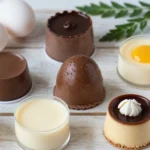We’ve all been there – craving a sweet treat but wanting to stick to our healthy eating goals. That’s where protein balls come to the rescue! These bite-sized powerhouses pack serious nutritional punch while satisfying your dessert cravings without the guilt.
Protein balls have become the ultimate grab-and-go snack for fitness enthusiasts and busy families alike. They’re incredibly versatile, requiring no baking, and can be customized with your favorite flavors and ingredients. From chocolate peanut butter to coconut lime, the possibilities are endless.
What makes these little spheres of goodness so appealing? They’re loaded with protein, healthy fats, and natural sweeteners that keep you energized throughout the day. Plus, you can whip up a batch in just 15 minutes and store them for the entire week. Whether you’re meal prepping or need a quick post-workout snack, these protein-packed treats deliver both convenience and nutrition in every bite.
Essential Equipment for Making Protein Balls
Making protein balls requires minimal equipment that most home cooks already have in their kitchen. We recommend gathering these essential tools before starting your protein ball preparation to ensure smooth and efficient mixing.
Mixing Bowl
A large mixing bowl serves as the foundation for combining all ingredients. We prefer using a medium to large stainless steel or glass bowl that provides ample space for thorough mixing without ingredients spilling over the edges. The bowl should be deep enough to accommodate vigorous stirring and folding motions.
Food Processor or High-Powered Blender
A food processor transforms nuts, dates, and other whole ingredients into the perfect consistency for binding protein balls together. We find that a 7-cup capacity food processor handles most recipes efficiently. High-powered blenders like Vitamix also work well for smaller batches and create smoother textures when processing sticky ingredients like dates and nut butters.
Measuring Cups and Spoons
Accurate measurements ensure consistent results every time we make protein balls. We use both dry and liquid measuring cups along with a complete set of measuring spoons. Digital kitchen scales provide even more precision for ingredients like protein powder and nut butters that can vary significantly when measured by volume.
Cookie Scoop or Small Ice Cream Scoop
A small cookie scoop creates uniform protein balls that look professional and portion consistently. We recommend using a 1-tablespoon or 1.5-tablespoon scoop for standard-sized protein balls. This tool eliminates the mess of rolling balls by hand and speeds up the formation process significantly.
Baking Sheet or Large Plate
A flat surface lined with parchment paper provides the ideal workspace for placing formed protein balls. We use rimmed baking sheets that fit easily in our refrigerator or freezer for the chilling process. The parchment paper prevents sticking and makes transferring the finished balls much easier.
Airtight Storage Containers
Proper storage containers maintain freshness and prevent protein balls from absorbing refrigerator odors. We prefer glass containers with tight-fitting lids that stack neatly in the refrigerator. These containers should be large enough to hold a single layer of protein balls without crowding.
Basic Protein Ball Base Ingredients

Every successful protein ball recipe starts with four essential components that work together to create the perfect texture and nutritional profile. We’ll explore each category to help you build your ideal protein ball foundation.
Protein Powder Options
Whey protein delivers the highest protein content and works exceptionally well for muscle recovery after workouts. This fast-absorbing option blends seamlessly into most protein ball recipes.
Casein protein offers a slow-digesting alternative that’s perfect for overnight muscle recovery. We recommend this option when making protein balls as evening snacks.
Plant-based proteins including pea, hemp, or rice proteins provide excellent alternatives for vegan diets. These options maintain the same binding properties while accommodating dietary restrictions.
| Protein Type | Digestion Speed | Best For |
|---|---|---|
| Whey | Fast | Post-workout recovery |
| Casein | Slow | Overnight muscle repair |
| Plant-based | Moderate | Vegan diets |
Natural Binding Agents
Rolled oats serve as the primary base ingredient that provides chewy texture while helping bind all components together. We use these in nearly every protein ball recipe for their reliable consistency.
Flaxseed acts as a powerful binder while adding omega-3 fatty acids to boost nutritional value. Ground flaxseed works better than whole seeds for optimal binding.
Nut butter functions as both a binding agent and flavor enhancer. Peanut butter and almond butter are our top choices for creating cohesive protein balls that hold their shape.
Healthy Fats and Nuts
Almonds, walnuts, and pecans add satisfying crunch while providing healthy fats that keep you fuller longer. We chop these nuts roughly to maintain texture without overwhelming the mixture.
Sunflower seeds and chia seeds contribute additional nutrition and a subtle nutty flavor. These seeds work particularly well when you want extra protein without changing the overall taste profile.
Natural Sweeteners
Honey offers rich flavor complexity along with natural nutritional benefits that refined sugars lack. We find honey creates the perfect sticky consistency for binding ingredients.
Maple syrup provides a vegan-friendly sweetening option with its distinctive taste that complements nutty flavors beautifully. Pure maple syrup works better than artificial alternatives for both flavor and binding properties.
Agave nectar serves as another plant-based sweetener that dissolves easily into protein ball mixtures. This option works especially well when you prefer milder sweetness levels.
Classic Peanut Butter Protein Balls

Our most beloved protein ball recipe combines the irresistible flavor of peanut butter with wholesome ingredients for a perfect grab-and-go snack. These classic treats deliver approximately 9g of protein per ball while satisfying your sweet tooth naturally.
Ingredients
- 1 cup drippy all-natural peanut butter
- 1/3 cup vanilla protein powder
- 1/2 cup rolled oats
- 1 tablespoon chia seeds
- 2 tablespoons honey
- 1/4 cup mini chocolate chips
- 1-4 teaspoons water
Instructions
- Combine Ingredients: Place peanut butter, protein powder, oats, chia seeds, honey, and mini chocolate chips into a medium bowl.
- Mix the Dough: Use a wooden spoon or your hands to mix the dough together. Add water by the teaspoon to achieve the right consistency based on your peanut butter’s thickness.
- Form Balls: Use a 1 tablespoon cookie scoop to portion the dough evenly. Roll each portion into smooth balls until all dough is used, yielding 14-16 protein balls total.
- Store: Place finished balls in an airtight container and refrigerate for up to one week. For longer storage, freeze the protein balls for up to 3 months while maintaining optimal texture and freshness.
| Nutritional Information | Per Ball |
|---|---|
| Protein Content | 9g |
| Total Yield | 14-16 balls |
| Refrigerator Storage | 1 week |
| Freezer Storage | 3 months |
We recommend adjusting water quantity based on your peanut butter’s natural consistency for optimal binding. Some variations include adding flaxseed or PBfit powder for enhanced nutritional benefits and texture variety.
Chocolate Chip Cookie Dough Protein Balls

These protein-packed treats capture the nostalgic flavor of raw cookie dough while delivering substantial nutritional benefits. We’ve crafted this recipe to satisfy your sweet tooth without compromising your health goals.
Ingredients
- 1 cup oat flour
- 2 scoops vanilla protein powder
- ¼ cup peanut butter
- ¼ cup honey
- 1 teaspoon vanilla extract
- ¼ teaspoon salt (optional)
- ¼ cup almond milk (or any milk of choice)
- ¼ cup mini chocolate chips
Alternative Recipe Variation:
- ½ cup cashew butter
- ½ cup almond flour
- 40 grams collagen peptides (2 scoops)
- 3 tablespoons maple syrup
- ½ teaspoon vanilla extract (optional)
- Pinch of sea salt
- ½ cup chocolate chips
Instructions
Mix the base ingredients by combining oat flour, protein powder, peanut butter, honey, vanilla extract, and salt in a large bowl using a silicone spatula.
Gradually incorporate the almond milk one tablespoon at a time until the mixture reaches a cookie dough consistency that holds together when pressed.
Fold the mini chocolate chips into the mixture until evenly distributed throughout the dough.
Shape the mixture into balls by rolling portions between your palms and placing them on a parchment-lined baking sheet.
Freeze the protein balls until they firm up completely before transferring to a sealed container for storage.
For the alternative version, combine cashew butter, almond flour, collagen peptides, maple syrup, vanilla extract, and salt before folding in chocolate chips and forming into 12-14 balls.
| Storage Method | Duration | Container Type |
|---|---|---|
| Refrigerator | Up to 2 weeks | Airtight container |
| Freezer | Up to 3 months | Sealed freezer bag |
Create a nut-free version by substituting sun butter or tahini for peanut butter while maintaining the same measurements and preparation method.
No-Bake Coconut Almond Protein Balls

These tropical inspired protein balls bring together the rich flavors of coconut and almond in a convenient no bake format. We love how the natural sweetness of dates pairs with protein powder to create a satisfying snack that feels indulgent while supporting your fitness goals.
Ingredients
- 1 cup old fashioned oats (or rolled oats)
- ½ cup unsweetened shredded coconut
- 2 tablespoons almond butter
- 1 tablespoon honey or maple syrup
- 1 scoop vanilla or chocolate protein powder
- 1 tablespoon ground flax seeds (optional)
- 1 teaspoon vanilla extract
- 2-3 Medjool dates (optional for added sweetness)
- Water (as needed)
Instructions
Add the oats coconut almond butter honey protein powder and ground flax seeds to your food processor. Pulse the mixture until all ingredients begin to combine and form a coarse texture.
Pour in the vanilla extract and blend until the mixture becomes well incorporated. Drop in the Medjool dates if you prefer extra sweetness and continue blending until they break down completely into the mixture.
Shape the mixture into small balls using your hands and pressing firmly to ensure they hold together. Add a tablespoon of water at a time if the mixture feels too dry and crumbly to form proper balls.
Roll each protein ball in the remaining unsweetened shredded coconut until completely coated. Press gently to help the coconut adhere to the surface of each ball.
Place the finished balls on a plate or parchment lined baking sheet and refrigerate for at least 30 minutes. Store the protein balls in an airtight container in the refrigerator for up to one week or freeze them for longer storage up to three months.
Oatmeal Raisin Protein Balls

We love these oatmeal raisin protein balls because they capture the comforting flavors of classic oatmeal cookies while delivering substantial nutritional benefits. These wholesome treats combine fiber-rich oats with protein powder to create the perfect post-workout snack or afternoon energy boost.
Ingredients
- 1½ cups old-fashioned rolled oats
- 2 scoops vanilla protein powder (50-60 grams)
- 1 cup cashew butter
- ¼ cup honey or maple syrup
- 2 tablespoons raisins
- ¼ teaspoon cinnamon
Instructions
- Combine dry ingredients by mixing oats and protein powder in a large bowl until evenly distributed.
- Add wet ingredients by incorporating cashew butter and honey or maple syrup into the dry mixture. Mix thoroughly until the ingredients form a cohesive dough.
- Fold in flavor additions by gently mixing in raisins and cinnamon until they are evenly dispersed throughout the mixture.
- Shape the balls using your hands to roll the mixture into 14-16 uniform balls, approximately 1 inch in diameter each.
- Chill until firm by placing the protein balls on a parchment-lined baking sheet and refrigerating for at least 30 minutes before serving.
| Nutritional Information | Per Ball |
|---|---|
| Protein Content | ~8-9g |
| Total Balls Yield | 14-16 |
| Storage Time (Refrigerated) | Up to 1 week |
| Storage Time (Frozen) | Up to 3 months |
Double Chocolate Protein Balls

These decadent double chocolate protein balls deliver rich cocoa flavor while providing substantial protein content for your active lifestyle. The combination of chocolate protein powder and cocoa creates an indulgent treat that satisfies chocolate cravings without derailing your nutrition goals.
Ingredients
- 1/2 cup chocolate protein powder
- 3 tablespoons cocoa powder
- 1 teaspoon vanilla extract
- 5 large Medjool dates, pitted
- 1/3 cup runny peanut butter (or other nut butter)
- 1/2 cup almond milk
For the chocolate coating:
- 3/4 cup unsweetened melted chocolate
- 1 tablespoon coconut oil
Optional additions for texture and flavor:
- Chopped nuts
- Shredded coconut
- Dried fruit
- Hemp seeds
Instructions
Combine Ingredients: Add all ingredients except the chocolate coating components to your food processor. Blend until the mixture reaches a smooth consistency and holds together when pressed.
Form Bites: Roll the mixture between your palms to create uniform balls approximately 1 inch in diameter. Alternatively, press the mixture into silicone molds for consistent shapes.
Chill: Arrange the formed balls on a parchment-lined baking tray. Freeze for 20-30 minutes until they firm up and hold their shape well.
Prepare Chocolate Coating: Melt the unsweetened chocolate with coconut oil in a double boiler or microwave, stirring until smooth and glossy.
Coat Bites: Remove the chilled balls from the freezer. Dip each ball into the melted chocolate mixture using a fork, allowing excess chocolate to drip off before transferring.
Set: Place the chocolate-coated balls back on the parchment-lined tray. Refrigerate for approximately 30 minutes until the chocolate coating sets completely and becomes firm to the touch.
Store these protein balls in an airtight container in the refrigerator for up to one week. For longer storage, freeze them for up to three months. Alternative coating options include rolling the balls in chopped nuts or shredded coconut instead of using melted chocolate for different textures and flavors.
Lemon Coconut Protein Balls

These zesty lemon coconut protein balls combine tropical flavors with a bright citrus twist. We’ve perfected this recipe to deliver refreshing taste alongside impressive nutritional benefits.
Ingredients
- 1/2 cup vanilla or coconut protein powder
- 1/2 cup melted coconut oil
- 3/4 cup unsweetened shredded coconut
- 2 tablespoons honey
- 2 tablespoons fresh lemon juice plus zest
- 2 tablespoons coconut flour (optional)
Alternative Ingredient Options:
- Almond flour instead of coconut flour
- Chia seeds for added texture and nutrition
- Cashews and oats for different protein powder variations
Instructions
- Combine the base ingredients by mixing protein powder and melted coconut oil in a large mixing bowl until smooth.
- Add the flavor components by stirring in unsweetened shredded coconut, honey, fresh lemon juice, and lemon zest until well incorporated.
- Adjust consistency by gradually adding coconut flour if the mixture feels too wet or sticky for shaping.
- Form the protein balls using your hands or a cookie scoop to create uniform 1-inch spheres from the mixture.
- Chill for optimal texture by placing the formed balls on a parchment-lined plate and refrigerating for 30-45 minutes.
- Store properly in an airtight container in the refrigerator for up to 5 days to maintain freshness and texture.
| Storage Method | Duration | Container Type |
|---|---|---|
| Refrigerated | 5 days | Airtight container |
| Room temperature | 2-3 days | Sealed container |
The chia seed variation adds extra nutritional stability while cashew and oat versions provide different textures for those seeking variety in their protein ball repertoire.
Storage and Make-Ahead Instructions

Proper storage extends the life of your protein balls while maintaining their texture and nutritional value. We recommend following these proven methods to keep your homemade treats fresh and ready to enjoy.
Refrigerator Storage
We store our protein balls in airtight containers to maintain optimal freshness and prevent them from absorbing other flavors. Glass storage containers or reusable bags work perfectly for keeping protein balls firm and fresh in the refrigerator for up to two weeks. The cool temperature helps preserve the binding agents and prevents spoilage while maintaining the ideal texture we love in these nutritious snacks.
Freezer Storage
We freeze protein balls for extended storage by arranging them on a baking sheet and flash freezing for at least two hours until firm. Once frozen solid, we transfer the balls to freezer-safe containers or bags, labeling them with the date for easy tracking. Properly stored protein balls maintain their quality in the freezer for up to three months, giving us plenty of time to enjoy our batch.
When we’re ready to eat frozen protein balls, we have several thawing options. Room temperature thawing takes just a few minutes, while overnight refrigerator thawing works perfectly for planned snacking. Many of us actually prefer eating protein balls straight from the freezer for a firmer, ice cream-like texture.
Meal Prep Tips
We use cookie scoops to create consistently sized protein balls while minimizing the sticky dough from adhering to our hands. This technique streamlines the preparation process and ensures uniform portions for accurate nutritional tracking. Creating multiple flavors in one prep session gives us variety throughout the week without additional effort.
| Storage Method | Duration | Container Type |
|---|---|---|
| Refrigerator | 1-2 weeks | Airtight glass containers or reusable bags |
| Freezer | Up to 3 months | Freezer-safe bags or containers |
| Room Temperature | Few days only | Cool, dry place in airtight container |
We adjust the mixture consistency during preparation to ensure proper ball formation. Adding more nut butter, honey, or coconut oil helps when the mixture feels too dry, while extra oats or protein powder corrects overly wet mixtures. Portioning all balls at once before storage creates an efficient grab-and-go system for busy schedules.
For those managing nut allergies, we substitute sunflower seed butter for nut butter varieties without compromising taste or texture. We recommend consuming one to two protein balls per day for optimal nutritional benefits while avoiding overconsumption of these calorie-dense treats.
Customization Tips and Variations

Creating the perfect protein ball means adapting our base recipes to match your unique taste preferences and dietary needs. We can transform any basic protein ball recipe into countless delicious variations through strategic ingredient swaps and creative additions.
Flavor Combinations
Our superfood protein balls deliver exceptional nutritional density by incorporating acai berry powder and super greens powder alongside vanilla protein powder. This powerhouse combination creates a vibrant taste while maximizing your daily nutrient intake.
Classic peanut butter protein balls remain our most popular variation. We combine creamy peanut butter with rolled oats and your favorite protein powder to achieve that nostalgic flavor profile everyone craves.
For a playful twist we love making monster cookie protein balls that blend peanut butter and oats with colorful candy-coated pieces. Kids and adults alike gravitate toward this fun combination that feels indulgent while delivering solid nutrition.
Texture Modifications
Adding chopped almonds or walnuts transforms smooth protein balls into satisfying crunchy treats. We recommend roughly chopping these nuts to create pleasant texture contrasts without overwhelming the base flavors.
Creating soft and chewy protein balls requires incorporating Medjool dates or dried apricots into our mixture. These natural ingredients bind beautifully while adding subtle sweetness and that perfect chewy consistency.
Rolling finished protein balls in shredded coconut or finely chopped nuts provides an elegant coating that enhances both texture and visual appeal. We suggest chilling the balls first to help coatings adhere properly.
Dietary Substitutions
Our gluten-free protein balls use certified gluten-free oats to accommodate those with gluten sensitivities. Always verify that your oats carry proper certification to ensure complete gluten elimination.
Vegan protein balls require selecting plant-based protein powders while avoiding animal-derived ingredients like honey or gelatin. We substitute maple syrup or agave nectar for honey to maintain binding properties and sweetness.
Low-calorie variations use reduced-fat nut butters and minimize added sugars throughout the recipe. These modifications can significantly reduce the caloric content while preserving protein density and flavor satisfaction.
Troubleshooting Common Issues

Even experienced home cooks encounter challenges when making protein balls. We’ve compiled answers to the most common problems you might face during preparation.
Too Dry or Crumbly
When your protein ball mixture crumbles apart or feels dry to the touch, the issue typically stems from the absorbency of your protein powder or overly dry nut butters. Different protein powders absorb moisture at varying rates, which can leave your mixture lacking the binding power needed for proper ball formation.
We recommend adding small amounts of liquid gradually to achieve the perfect consistency. Start with one tablespoon of water, almond milk, or additional nut butter. Greek yogurt works exceptionally well as a binding agent while adding extra protein to your mixture. Mix thoroughly after each addition and test the consistency by pressing the mixture together in your palm. The mixture should hold its shape without cracking when pressed firmly.
Avoid adding too much liquid at once, as this can quickly swing your mixture from too dry to too wet. We suggest waiting a few minutes between additions to allow the dry ingredients to fully absorb the moisture before determining if more liquid is needed.
Too Wet or Sticky
Sticky or overly wet protein ball mixture often results from insufficient dry ingredients or using particularly moist binding agents. This consistency makes rolling nearly impossible and can lead to protein balls that won’t hold their shape during storage.
We solve this problem by incorporating more dry ingredients in small increments. Add one tablespoon of oat flour or additional protein powder at a time, mixing thoroughly between additions. Sometimes letting the mixture rest for five to ten minutes allows the protein powder to absorb excess moisture naturally without requiring additional dry ingredients.
Chilling the mixture for 15-20 minutes in the refrigerator can also firm up slightly wet mixtures without altering the ingredient ratios. This technique works particularly well when using fresh nut butters or when working in warm kitchen conditions.
Rolling and Shaping Problems
Achieving perfectly round, uniform protein balls requires the right mixture consistency and proper technique. Inconsistent textures within your mixture can create protein balls that crack during rolling or refuse to maintain their shape.
We ensure smooth rolling by addressing texture issues first. Follow our answers for dry or wet mixtures as needed before attempting to shape your protein balls. Using a cookie scoop creates uniform portions and reduces handling time, which prevents the mixture from warming up and becoming sticky.
Slightly damp hands help prevent sticking during the rolling process. We recommend chilling the mixture for 10-15 minutes before shaping if it feels too soft or sticky to handle comfortably. Rolling between your palms with gentle pressure creates the smoothest finish, while pressing too firmly can cause cracking or an uneven surface.
Nutritional Benefits and Serving Suggestions

Impressive Nutritional Profile
Protein balls deliver exceptional nutritional value packed into convenient bite-sized portions. Each serving provides approximately 7.25g to 9g of protein depending on the recipe variation, making them an excellent source of muscle-building nutrients. We particularly appreciate how these snacks combine protein with fiber-rich ingredients like oats and chia seeds to support digestive health and sustained energy release.
The healthy fats from almonds and peanut butter contribute to heart health while providing satiety between meals. Natural carbohydrates from dates and dried apricots offer quick energy without artificial additives or processed sugars. Our Superfood Protein Balls contain 153 calories per ball, delivering balanced macronutrients that fuel your body efficiently.
| Recipe Type | Calories per Ball | Protein Content | Fiber Content |
|---|---|---|---|
| Superfood Protein Balls | 153 | 7.25g | Varies |
| Peanut Butter Protein Balls | Varies | 5-9g | 3g |
Optimal Serving Times and Portions
Post-workout consumption maximizes the muscle recovery benefits of these protein-rich snacks. We recommend enjoying one to two protein balls within 30 minutes after exercise when your muscles are most receptive to protein synthesis. The high protein content supports tissue repair while natural sugars help replenish glycogen stores.
Busy mornings become manageable with protein balls as a grab-and-go breakfast option. They provide sustained energy without the blood sugar spikes associated with traditional breakfast pastries or sugary cereals. Mid-afternoon snacking becomes more nutritious when you reach for these homemade treats instead of processed alternatives.
Versatile Serving Applications
Lunch box additions transform ordinary meals into balanced nutritional experiences. Children and adults alike benefit from the portable nature of protein balls, which require no refrigeration for several hours. We find they pair exceptionally well with fresh fruit or yogurt for complete meal satisfaction.
Office snacking reaches new heights when you stock your desk drawer with these nutrient-dense alternatives to vending machine options. The combination of protein, healthy fats, and natural sweeteners prevents energy crashes while supporting focus and productivity throughout demanding workdays.
Conclusion
We’ve explored the industry of protein balls and discovered why they’ve become such a popular choice for health-conscious snackers. From classic peanut butter to tropical lemon coconut variations these versatile treats offer endless possibilities for customization.
The beauty of protein balls lies in their simplicity and flexibility. Whether you’re following a exact diet addressing allergies or simply looking for a quick energy boost there’s a recipe that’ll work for your lifestyle.
We encourage you to experiment with different flavor combinations and find your perfect protein ball recipe. With proper storage techniques and our troubleshooting tips you’ll be creating delicious nutritious snacks that support your wellness goals for weeks to come.
Frequently Asked Questions
What are protein balls and why are they popular?
Protein balls are no-bake, bite-sized snacks made with protein powder, healthy fats, and natural sweeteners. They’re popular among fitness enthusiasts and busy families because they satisfy sweet cravings guilt-free, provide sustained energy, and can be customized with various flavors. They’re also incredibly convenient for meal prepping and post-workout recovery.
How much protein do protein balls contain?
Most protein balls contain approximately 7-9 grams of protein per ball, depending on the recipe and ingredients used. This makes them an excellent snack for meeting daily protein requirements, supporting muscle recovery after workouts, and maintaining sustained energy levels throughout the day.
What basic equipment do I need to make protein balls?
You’ll need a large mixing bowl, food processor or high-powered blender, measuring cups and spoons, and a cookie scoop for uniform sizing. A baking sheet lined with parchment paper and airtight storage containers are also helpful for chilling and storing your protein balls properly.
How long do protein balls last and how should I store them?
Protein balls can be stored in airtight containers in the refrigerator for up to two weeks or frozen for up to three months. For freezing, flash freeze them on a baking sheet first, then transfer to freezer-safe containers. Always keep them refrigerated to maintain freshness and texture.
Can I make protein balls without nuts for allergies?
Yes! You can substitute nut butters with sunflower seed butter, tahini, or sun butter for nut-free versions. These alternatives provide similar binding properties and healthy fats while accommodating those with tree nut or peanut allergies without compromising taste or texture.
What’s the best time to eat protein balls?
Protein balls are versatile and can be enjoyed post-workout for muscle recovery, as a grab-and-go breakfast, or as an afternoon snack. They’re also perfect for lunch boxes, office snacks, and pair well with fruits or yogurt for balanced meals.
How do I fix protein ball mixture that’s too dry or wet?
For dry mixtures, gradually add small amounts of liquid (water, milk, or nut butter) until the mixture holds together. For wet mixtures, incorporate more dry ingredients like protein powder, oats, or flour until you achieve a moldable consistency that rolls easily into balls.
Can protein balls be customized for different dietary needs?
Absolutely! Protein balls can be adapted for gluten-free diets (using gluten-free oats), vegan diets (plant-based protein and maple syrup), and low-calorie options (reducing sweeteners). You can also add superfoods like chia seeds, acai powder, or incorporate various nuts and dried fruits for customization.















